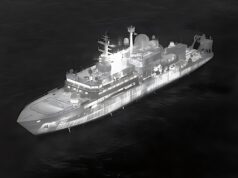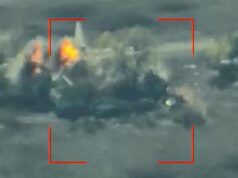The Gravehawk system, a recently developed air defence project jointly funded by the UK and Denmark, has entered its final testing phase.
In a Written Question answered on 4 February 2025, Luke Akehurst (Labour – North Durham) requested an update on the programme’s progress.
Maria Eagle, Minister of State at the Ministry of Defence, explained:
“The Gravehawk system is a rapidly developed bespoke air defence system, jointly funded by the UK and Denmark. This innovative system, which is able to retrofit air-air missiles for ground-based air defence, can use Ukrainian missiles already in their armed forces’ possession.
With Ukraine under constant Russian bombardment, the Gravehawk system will boost Ukraine’s air defences, allowing them to defend their cities, troops and critical infrastructure. Two prototypes of the air defence capability system were tested in Ukraine in September 2024, and a further 15 will follow this year.”
While no additional technical details were provided, the announcement indicates ongoing bilateral efforts to strengthen Ukrainian air defence capabilities. Gravehawk’s ability to repurpose existing stockpiles of air-to-air missiles for ground-based use could expedite its operational readiness. The system’s future deployment timeline remains subject to the outcomes of the current testing process.













Thinking of us, here, but would it be a good idea for us to adopt this as well and incorporate Meteor missiles on to Gravehawk?
They’ve got a good range, much better than that of the CAMM missiles being used by Sky Sabre. Would this not be a viable option for UK-based air defence?
From what I understand, Meteor would require an additional booster for ground launch. Meteor does have a solid rocket booster packed into the “ramjet’s” combustion chamber and exhaust. This is used in conjunction with the aircraft’s kinetic energy to accelerate the missile past Mach 1.2 (realistically Mach 1.6) to enable the ramjet to work. From the ground with denser air to push through, I don’t believe the internal rocket motor has the oomph to get it to the speed for the ramjet to take over.
However, with a expendable external rocket booster, Meteor would make an excellent surface to air weapon.
I think the Meteor would need another solid booster phase added to reach several thousand feet to be efficient, and speed for the ramjet to be used. From what I have read, Meteor’s performance is more efficient when air-launched at very high altitudes. Also, I have seen price tags of £2m per missile. I’m sure someone will have more knowledge, but this is what I have come across.
Sounds like £2Mn Meteor to stop £10K Shaheed drones is a bad economic situation and Ukraine has no stock of Meteor either. To be feasible without delay, there must be existing stock.
Don’t want a repeat of 155mm ammo, promised in large quantities yet not actually delivered to the front line.
With Ukrainian Air Force mostly on the ground in contested airspace, it makes sense to use existing missile stock for air defence as so much civilian infrastructure is at risk from enemy missiles and long range drones.
That’ll be partly due to the launch altitude I’d imagine. And with CAMM-ER/MR in development, is there much point trying to finagle another missile into a ground launched variant?
What I have gleaned from other sites, is that Gravehawk “Paladin” builds on the earlier Supacat HMT with the twin Tornado launch rails, that could fire ASRAAM. These other sites may be wrong, but I think they are in essence correct. However, the concept that has evolved is now purported to include:
“A 30-mm Mk44 Bushmaster II automatic cannon, with an option to upgrade to a 40 mm calibre. It is equipped with a radar featuring four AESA antennas for 360-degree coverage, and an optoelectronic targeting station SATOS, complete with a thermal imaging camera and laser rangefinder. This enables the system to autonomously detect, track, and neutralise targets in all weather conditions.”
One of the key new features is that it can launch Russian “designed” air to air weapons, like the infrared guided R73. Whilst also being NATO (MIL-STD-1760) missile capable. So in essence it seems that the system is much like a NASAMS. Though the only missiles mentioned for it so far are the within visual range infrared guided ones. The inclusion of a radar should enable it to use the beyond visual range missiles such as ASRAAM and the AA10 (R27), which Ukraine uses for its MiG-29 and Su-27.
The addition of the 30mm Bushmaster is a good option, allowing the system to intercept drones at a much lower cost. Apparently the whole system is built from military components that are available off the shelf. As this not only keeps development costs down, but also speeds up the system’s introduction.
If they are building additional systems on the back of the two they sent to Ukraine in September on live trials. I can assume this system was judged satisfactory. Remains to be seen if what has been purported above is the actual system.
If this such a bargain and very useful you’ve got to wonder if or when the UK might ever adopt some of these for itself? Shorad GBAD for bases ports etc.
Are we taking 30 mm guns from withdrawn T23 Frigates do you think.
Likely not, there were only 26 of the DS30M mounts brought for the navy and they are in current high demand and feature on numerous of the future ship designs in construction. The 30mm Bushmaster is very much surplus across NATO and not exactly expensive, as far as these things go, if they were prying them away from the navy instead of sourcing them from the huge pool of stored guns from across multiple continents (as the Terrahawk is designed specifically to be built from spare parts essentially) I’d be very concerned.
Why is nobody releasing pictures of this thing?
Surely, if it is heading for Ukraine, there isn’t any particularly sensitive technology?
Not sure Meteor will fit on the launch platform given that the largest AAM Ukraine has at present is AMRAAM and Meteor is significantly larger and faster.
Meteor is also much newer and you’d assume more sensitive.
Go to YouTube and type in Gravehawk also the plan is to use old Soviet missile the Ukrainians have.
Doesn’t that come up with images of the old ASRAAM Supacat mashup?
Not sure there’s anything new
If Gravehawk is the 30mm air defence, I would like to see a Marlet cluster attached.
Tridon Mk2 land air defence system would also be nice.
Good article on Army Technology about Gravehawk, if anyone’s interested.
Thanks.
Ah, yeah, searching Gravehawk brought up the 30mm on the Paladin. I remember seeing the images coming out for this a while ago, nice to know it now has a name.
Isn’t that called “Terrahawk”? Sounds like a very close relative…LOL 😄
I would imagine it’s essentially a ground launch system for asraam as the UK has a lot of those…good for Ukraine but also very good if the UK ever needed add mass to its GBAD.. if this is something Uk industry can knock out quickly and it uses a missile the RAF hold a lot of stock of and is quick to build in the Uk as well..it does in time of crisis mean the UK has an opportunity to upscale its GBAD to match the threat.
Maybe it’s worth producing a few of these for the UK reserve forces to have a core of trained individuals so if needed GBAD can be expanded by producing these and having the batteries manned by reservists.
The Ukrainian-Russo war is over, learn the lessons and move on.
♾️❤️☮️
Out here with the misinformation.
The war is not over, for all those interested.
I wonder if the confusion about what the exact configuration is purely because Gravehawk is technically referring to two different systems that collectively make up one overall package when combined?
i.e. Gravehawk has both an improved “missile” component that can also fire Russian AAMs like the R-73, AND a separate 30mm “gun” component (Paladin), that works in an overall air defence system better than its previous systems. Basically, improved versions of the previously sent ASRAAM/HMT Supacat and the 30mm Paladins sent earlier, that integrate more smoothly with each other/broader air defence networking in the newer “Gravehawk” configuration.
On a side-note, I’m curious if there’s any plans for a different turret set-up, so you don’t have missiles exposed to the elements (since they’re air to air versions, very different environmental factors compared to ground to air ones), or if it’s simply much quicker to just have modified pylons to whack whatever onto? NASAMS can fire AMRAAM, AIM-9X, AMRAAM-ER, so you can have a modular box launcher for different missiles, but that takes a lot longer time obviously. Perhaps the strict 2.5 ton weight limit on the HMT Supacat also is limiting major design changes? Still, one can hope for a Supacat boxed, modular twin or four missile launcher, capable of firing different missiles, with the mast-extendable, excellent passive Thales ROTOS system we’ve already seen in use, as a nice little mobile SHORAD set-up. One can dream!
Based on the comments here, that wouldn’t surprise me.
The Paladin 30mm setup was called Terrahawk when was originally displayed. Gravehawk may simply be a modification to the existing platform to fire missiles instead.
How standardised are missile launch rails? Can you launch both Western and Ex-Soviet missiles from the same platform?
According to reports about Gravehawk, yes.
We should be arming our own supplies more than ever now. This country will run out of ammunition warheads missiles bullets.
This happened after the First World War.
We have to start protecting this country rather than running to the USA for our supplies.
Could we get boostered meteor and use it to target glide bomb carrying aircraft. Wouldn’t need very many after you shoot a few su35s down russians will have to withdraw difficult to replace strike aircraft.